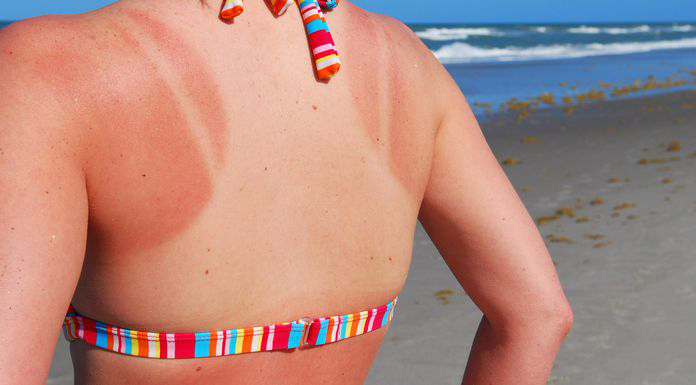Sunburn is an acute, delayed, and transient inflammatory response of the skin after exposure to ultraviolet radiation (UVR) from sunlight or artificial sources. Sunburn is characterized by erythema and, if severe, by vesicles and bullae, edema, tenderness, and pain; in normal sunburn there are never “rashes,” i.e., scarlatiniform macules, papules, or plaques that occur in abnormal reactions to UVR. UVR in photomedicine is divided into two principal types: UVB (290 to 320 nm), the “sunburn spectrum,” and UVA (320 to 400 nm). UVA has been subdivided into UVA-1 (340 to 400 nm) and UVA-2 (320 to 340 nm). The unit of measurement of sunburn is the minimum erythema dose (MED), which is the minimum ultraviolet exposure that produces a clearly marginated erythema in the irradiated site after a single exposure. The MED is expressed in the amount of energy per unit area: mJ/cm² (UVB) or J/cm² (UVA). The MED for UVB in Caucasians is 20 to 40 mJ/cm² (for a skin phototype I or II, about 20 min in northern latitudes at noon in June) and for UVA is 15 to 20 J/cm² (about 120 min in northern latitudes at noon in June). UVB erythema develops in 6 to 24 h and fades within 72 to 120 h. UVA erythema peaks between 4 to 16 h and fades within 48 to 120 h.
Causes of Acute Sun Damage (Sunburn)
The chromophores (molecules that absorb UVR) for UVB sunburn erythema are not known, but damage to DNA possibly may be the initiating event. The damage to DNA, in fact, results in excision of pyrimidine dimers which sui generis initiates a protective tanning response. The mediators that cause the erythema include histamine for both UVA and UVB. In UVB erythema, other mediators include serotonin, prostaglandins, lysosomal enzymes, and kinins. However, the cytokine interleukin 6 (IL-6) that peaks at 12 h is probably the main mediator of the sunburn reaction in humans.
Symptoms of Acute Sun Damage (Sunburn)
- Redness
- Swelling
- Warmth
- Pain
- Blisters
- Fever
- Chills
- Nausea and vomiting in severe cases
- Weakness
- Symptoms of shock, including Low blood pressure, Fainting, Extreme weakness (in rare and serious cases)
Diagnosis
A mild sunburn does not usually require a visit to the doctor. However, if you have any of the above symptoms, seek medical attention. The doctor will ask about your symptoms and medical history, and perform a physical exam. For more severe cases of sun damage, you may be referred to a doctor who specializes in skin disorders (dermatologist). History of UVR exposure and sites of reaction on exposed areas.
Video
Treatment
Moderate Sunburn
Topical Cool wet dressings, topical glucocorticoids.
Systemic Acetylsalicylic acid, indomethacin.
Severe Sunburn Bed rest. If very severe, a “toxic” patient is best managed in a specialized “burn unit” for fluid replacement, prophylaxis of infection, etc.
Topical Cool wet dressings, topical glucocortcoids.
Systemic Oral glucocorticoids are often given, but their efficacy has not been established by controlled studies.
Prevention
There are now many highly effective topical chemical filters (sunscreens) in lotion, gel, and cream formulations. Persons with SPT I or II should avoid sunbathing, especially between 1100 and 1400 h. Clothing: UV-screening cloth garments. It is still not clear whether regular use of topical sunscreens can prevent melanoma of the skin, but there is a general belief that topical sunscreens reduce the induction of solar keratoses and, probably, squamous cell carcinoma.
References
